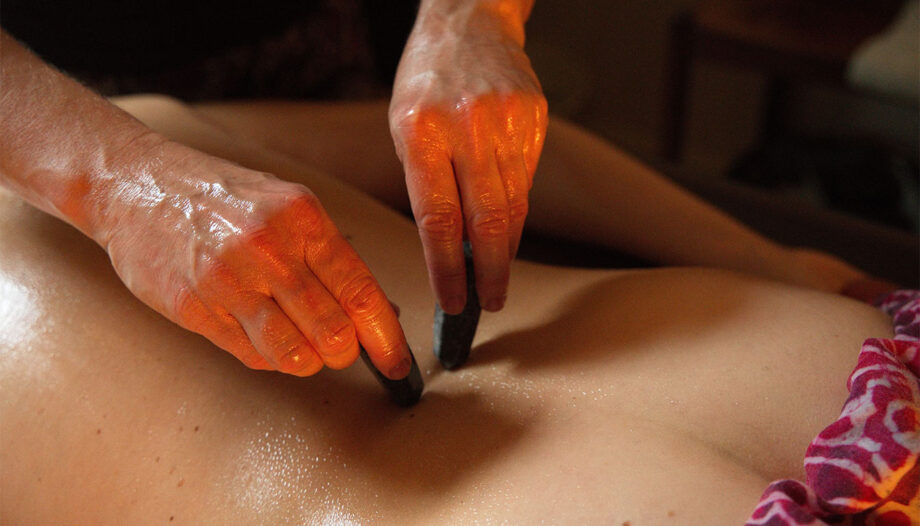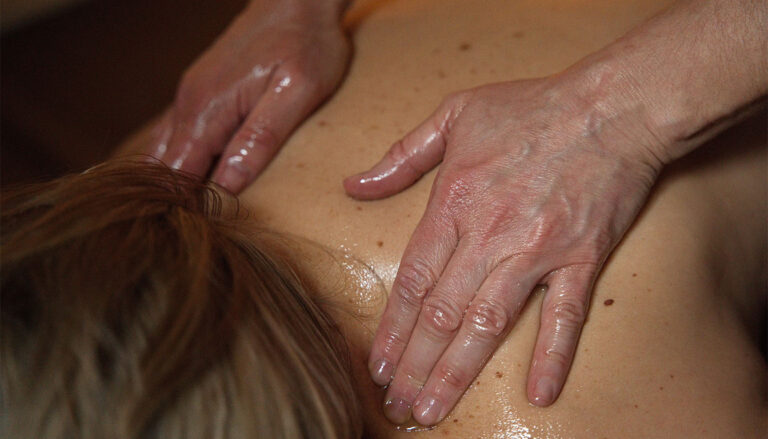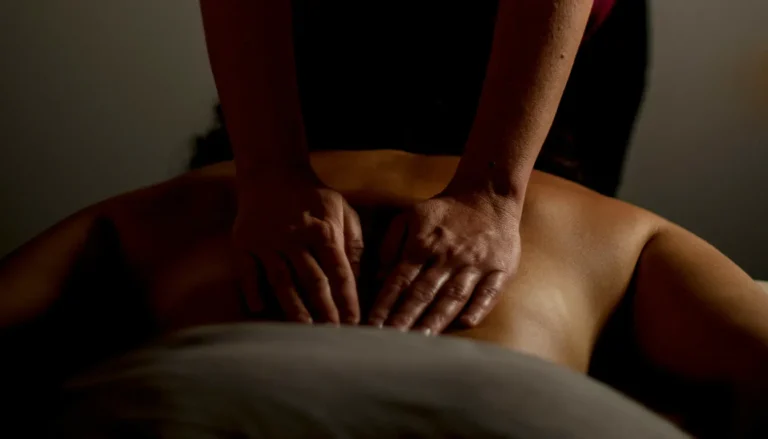Dealing with a trapped nerve can make daily life tough. It leads to discomfort like pain and tingling feelings. Luckily, massage therapy can offer some relief. It helps by easing the pressure on the nerve and improving movement. By loosening the soft tissues around the nerve, massage not only helps right away but also aids in long-term healing. In this article, we’ll look into how massage therapy can specifically help with trapped nerves. It gives hope to those suffering from ongoing pain123.
A Brief Introduction to Trapped Nerves
Trapped nerves or pinched nerves happen when tissues like bones, muscles, or tendons squeeze a nerve. This can cause discomfort and symptoms. It’s common, especially in the lower back or neck, and can cause pain along the nerve pathways45. About 85 in 100,000 adults have this problem every year. This shows it’s quite common4.
Understanding Trapped Nerves
Nerve compression can come from many things. These include inflammation, physical harm, arthritis, and being overweight. Injuries can change the body and make trapped nerves more likely. Tests like electromyography (EMG) and nerve conduction studies (NCS) are important. They help find where and how bad the compression is5.
Symptoms to Look Out For
Symptoms can be burning, numbness, tingling, or weakness. They might be mild or severe and usually just on one side. Sometimes, trapped nerves can affect several places5. Knowing these signs is key to getting help early. Treatments like massage therapy can ease stress and boost circulation4.
What Causes a Trapped Nerve?
Trapped nerves can come from several sources. It’s vital to know these causes of trapped nerve for effective treatment. These factors can make daily life quite difficult by causing discomfort and symptoms.
Common Causes of Nerve Compression
Spinal issues, like herniated discs and arthritis, can press on nerves. Tasks that need repetitive hand or wrist actions, like assembly line work, also pose a big risk of nerve compression6. Most affected are adults aged 50 to 54, often due to spine degeneration that irritates nerves7.
Being overweight can put extra pressure on nerves. Pregnancy can swell nerve pathways due to water retention6. Resting in bed for too long also raises the risk of nerve compression7.
Impact of Soft Tissue on Nerve Health
The role of soft tissue is key in keeping nerves healthy. Bad posture can misalign and press on nerves, while soft tissue ailments like those affecting tendons and ligaments can cause inflammation8. Strength and flexibility exercises, along with regular breaks and correct posture, can help avoid trapped nerves. They are important for nerve care6
| Cause | Description |
|---|---|
| Herniated Discs | Discs bulge out and press on nearby nerves. |
| Repetitive Movements | Chronic use of specific joints leads to inflammation and pressure. |
| Obesity | Extra weight can compress nerves in various regions. |
| Poor Posture | Can cause misalignment and added pressure on nerves. |
| Pregnancy | Fluid retention can swell nerve pathways, causing compression. |
Can Massage Help Trapped Nerve?
Massage therapy offers massage benefits for issues like trapped nerves. Sufferers can have pain and discomfort, making daily activities hard. Massage can ease this pain, lessen swelling, and boost one’s wellness.
Benefits of Massage Therapy
Studies reveal massage can ease pain from problems like degenerative disc disease. It boosts blood flow, helping the body heal itself. Especially, since most acute pinched nerves improve alone in 8 to 12 weeks. Massage, coupled with rest and therapies like warm heat, could speed up recovery for trapped nerve relief9.
Types of Massage Effective for Trapped Nerves
Certain types of massage work well for pinched nerves:
- Deep Tissue Massage: Targets deep muscle layers to ease tension and pain.
- Swedish Massage: Uses soft techniques to release tight muscles, reducing the risk of nerve squeeze.
- Heat Therapy: Warm the area for 10-15 minutes to improve blood flow, then cool it to lower swelling.
Using these techniques can lessen pain and speed up healing. This is especially true when combined with gentle exercise and stretching10.
Choosing the Right Massage for Your Condition
Choosing the right massage is key when you’re dealing with a pinched nerve. It’s best to get a professional consultation before starting. This ensures the massage meets your specific needs. Always talk about symptoms like numbness or weakness with a healthcare pro.
Consulting with a Professional
Talking to a healthcare provider is important. They can figure out how severe your condition is and suggest the best treatments. These might include massage therapy, physical therapy, or chiropractic care. Every year, 85 out of 100,000 people in the States feel the pain of pinched nerves. This shows how crucial it is to get expert advice11.
What to Expect During a Massage Session
Your massage will be customised to tackle your specific discomfort. The therapist might use Swedish or deep tissue massage, depending on your pain. Swedish massage helps relax muscles with lighter pressure. Deep tissue massage is better for severe pain, like in your lower back1211.
Massage sessions usually last between thirty minutes to an hour, which helps a lot.
Having regular sessions instead of just a few can improve chronic conditions better13.Make sure to talk openly with your therapist. This helps them adjust their approach to suit you best.
Conclusion
Learning how to handle trapped nerves is key to bettering one’s life quality. A whopping 87% of folks report that massage therapy impact has bettered their health and happiness14. Techniques like deep tissue and Swedish massages help by easing muscle tension and boosting blood flow1516.
Getting professional advice for trapped nerves is vital. Talking to health experts can help you find the right massage therapist14. Plus, combing through therapies such as heat and perhaps physical therapy can speed up recovery16.
If you’re dealing with trapped nerve symptoms, talking to a health expert is crucial. Including suitable treatments like massage in your care approach can really help manage trapped nerves and boost your overall well-being.
FAQ
What are trapped nerves?
Trapped nerves, also known as pinched nerves, occur when tissues like bones, muscles, or tendons squeeze nerves. This leads to pain, numbness, or tingling. It’s a common problem for many adults.
What are the symptoms of trapped nerves?
Symptoms include pain, numbness, tingling, or weakness in the area. The specific nerve affected changes the symptoms. They can get worse with movement or when the nerve is pressed.
How can massage therapy help with trapped nerves?
Massage therapy reduces pain and swelling, boosts circulation, and relaxes tight muscles causing nerve compression. It’s beneficial for trapped nerves.
Are there specific types of massage that are effective for trapped nerves?
Yes, deep tissue massage, myofascial release, and trigger point therapy are great. They ease tightness and relieve muscle tension, helping with nerve compression.
What should I expect during a massage session for trapped nerves?
The therapist will check your condition and focus on tense areas. The treatment is tailored to your needs. You might feel some discomfort, but the goal is relaxation and relief.
Do I need to consult a professional before starting massage therapy for trapped nerves?
Yes, talking to a healthcare provider before starting massage therapy is key. They’ll assess your situation and suggest the best treatment to ensure safety and effectiveness.
How often should I get massage therapy for trapped nerves?
How often you need massage therapy depends on your needs and symptom severity. Often, it starts weekly, then less as you get better.
Can massage therapy be used in conjunction with other treatments for trapped nerves?
Absolutely! Massage therapy works well with other treatments like physical therapy, chiropractic care, and medication. It offers a well-rounded approach to symptom management.





